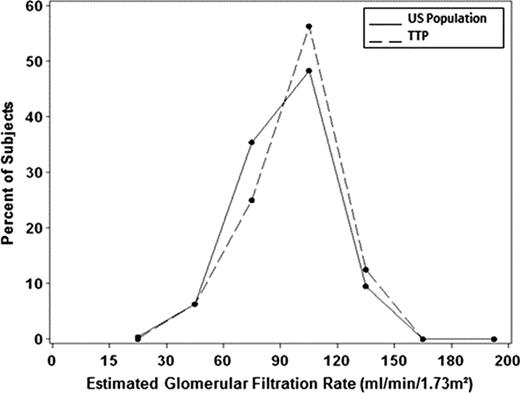Abstract
Abstract  2215
2215
Among survivors of TTP associated with severe ADAMTS13 deficiency, long-term outcomes other than relapse are not well documented. The recent report of persistent minor neurocognitive abnormalities attributed to subcortical microvascular thrombosis (Transfusion 2009;49:1092) suggested that other organs may also be affected by subclinical abnormalities. Therefore we documented renal function in patients in the Oklahoma TTP-HUS Registry who survived acute episodes of TTP associated with severe ADAMTS13 deficiency (activity <10%).
ADAMTS13 activity has been measured in 299 of 321 (93%) patients, 1995–2010. Glomerular filtration rate (GFR) was calculated by the Chronic Kidney Disease-Epidemiology Collaboration (CKD-EPI) equation (Ann Int Med 2009;150:604). Urine protein was measured by dipstick. Patient GFRs were compared to GFRs for the US population using data from the National Health and Nutrition Examination Survey (NHANES), 1998–2006, that had been analyzed in the CKD-EPI study.
68 of 299 (23%) patients from the Oklahoma TTP-HUS Registry had severe ADAMTS13 deficiency. Fifty-five of the 68 (81%) patients with severe ADAMTS13 deficiency survived their initial episode of TTP. Among the 55 survivors, 48 (87%) have had ≥1 year of follow-up (median, 6.4 years; range, 1.0 – 14.9 years). The 7 patients whose follow-up was less than 1 year included 3 patients whose initial episode was within the past year; 2 with systemic lupus erythematosus who died within one year; 1 who relapsed and died at one year; 1 lost to follow-up. Sixteen (33%) of the 48 patients had 1–4 relapses. None of the 48 patients developed end stage renal disease and none developed severe chronic kidney disease (GFR <30 ml/min/1.73m2). Three of the 48 patients had chronic kidney disease with moderately decreased GFR (GFR 30–59 ml/min/1.73m2); two of these patients had hypertension and one had hypertension and diabetes prior to their initial episodes of TTP. The median GFR was 97 ml/min/1.73m2 (range, 30 – 139 ml/min/1.73m2). The GFR for the ADAMTS13 deficient TTP patients was not different from the GFR of the U.S. population (p=0.289) (Figure 1). Urine protein was measured on 34 patients (median follow-up, 6.7 years; range, 1.2–14.9 years): 32 (94%) were negative; 2 (6%) were trace, equivalent to <30 μg albumin/mg creatinine.
Glomerular filtration rates (GFRs) for 48 TTP patients with severe ADAMTS13 deficiency who had been followed for a median of 6.4 years (range, 1.0 – 14.9 years) compared to the GFRs for the US population.
Glomerular filtration rates (GFRs) for 48 TTP patients with severe ADAMTS13 deficiency who had been followed for a median of 6.4 years (range, 1.0 – 14.9 years) compared to the GFRs for the US population.
Renal function of TTP patients with severe ADAMTS13 deficiency who had been followed for a median of 6.4 years following recovery from their initial episode was not different from the US population.
No relevant conflicts of interest to declare.
Author notes
Asterisk with author names denotes non-ASH members.

This icon denotes a clinically relevant abstract


This feature is available to Subscribers Only
Sign In or Create an Account Close Modal